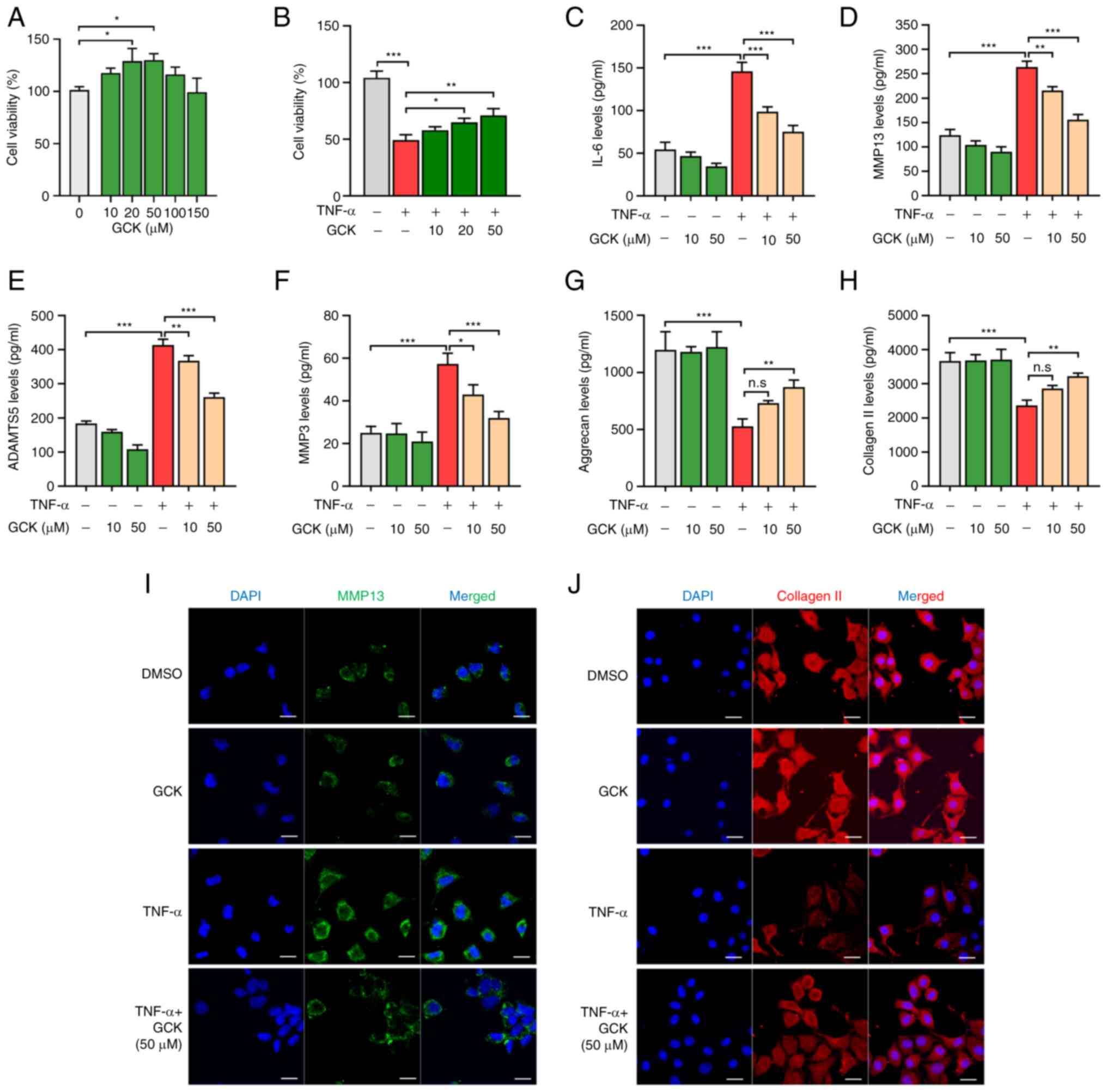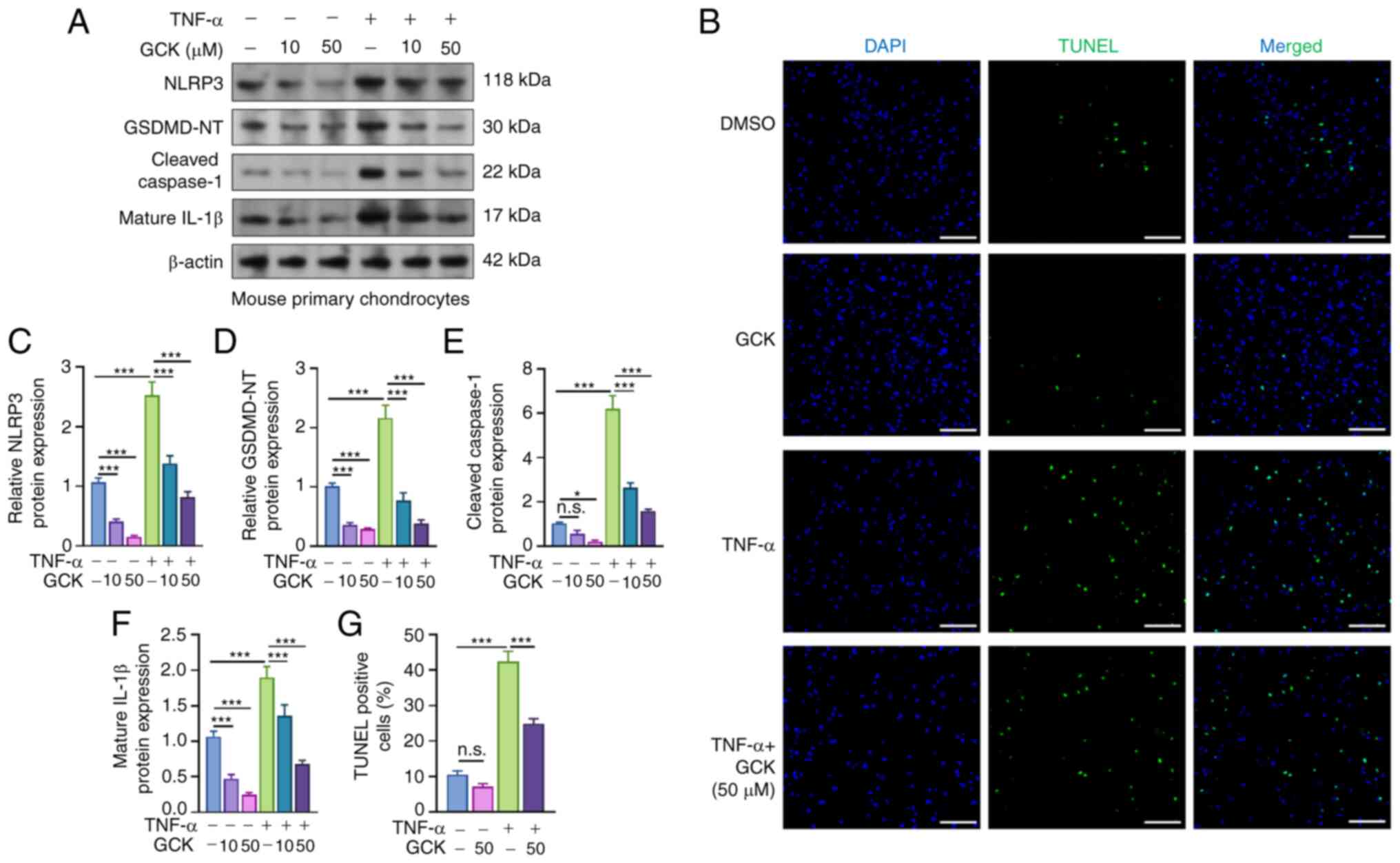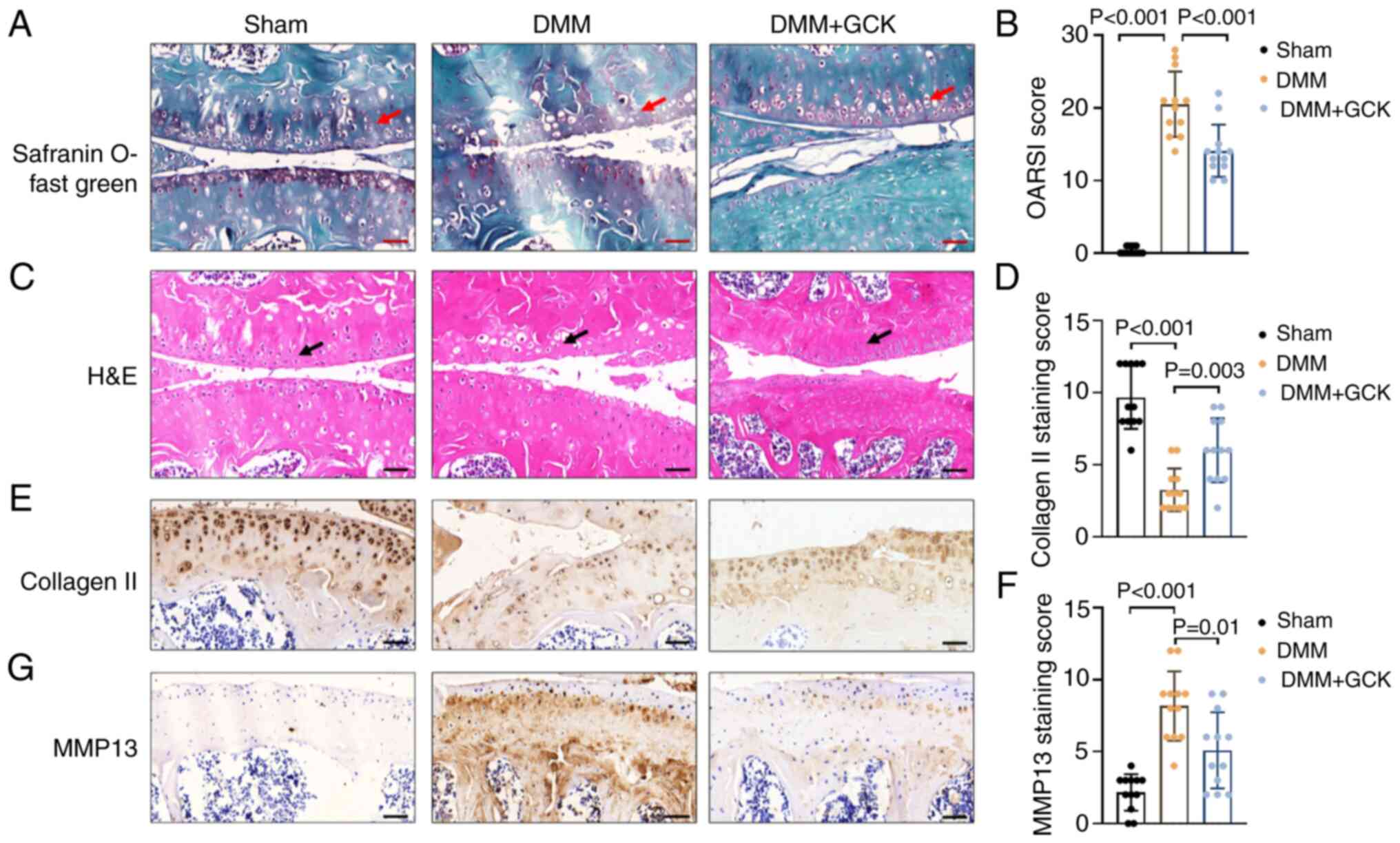|
1
|
Coryell PR, Diekman BO and Loeser RF:
Mechanisms and therapeutic implications of cellular senescence in
osteoarthritis. Nat Rev Rheumatol. 17:47–57. 2021.PubMed/NCBI View Article : Google Scholar
|
|
2
|
An S, Hu H, Li Y and Hu Y: Pyroptosis
plays a role in osteoarthritis. Aging Dis. 11:1146–1157.
2020.PubMed/NCBI View Article : Google Scholar
|
|
3
|
Yang J, Hu S, Bian Y, Yao J, Wang D, Liu
X, Guo Z, Zhang S and Peng L: Targeting cell death: Pyroptosis,
ferroptosis, apoptosis and necroptosis in osteoarthritis. Front
Cell Dev Biol. 9(789948)2022.PubMed/NCBI View Article : Google Scholar
|
|
4
|
Wu Y, Zhang J, Yu S, Li Y, Zhu J, Zhang K
and Zhang R: Cell pyroptosis in health and inflammatory diseases.
Cell Death Discov. 8(191)2022.PubMed/NCBI View Article : Google Scholar
|
|
5
|
Miao EA, Leaf IA, Treuting PM, Mao DP,
Dors M, Sarkar A, Warren SE, Wewers MD and Aderem A:
Caspase-1-induced pyroptosis is an innate immune effector mechanism
against intracellular bacteria. Nat Immunol. 11:1136–1142.
2010.PubMed/NCBI View
Article : Google Scholar
|
|
6
|
Yi YS: Ameliorative effects of ginseng and
ginsenosides on rheumatic diseases. J Ginseng Res. 43:335–341.
2019.PubMed/NCBI View Article : Google Scholar
|
|
7
|
Yang N, Liu D, Zhang X, Li J, Wang M, Xu T
and Liu Z: Effects of ginsenosides on bone remodelling for novel
drug applications: A review. Chin Med. 15(42)2020.PubMed/NCBI View Article : Google Scholar
|
|
8
|
Cheng W, Jing J, Wang Z, Wu D and Huang Y:
Chondroprotective effects of ginsenoside Rg1 in human
osteoarthritis chondrocytes and a rat model of anterior cruciate
ligament transection. Nutrients. 9(263)2017.PubMed/NCBI View Article : Google Scholar
|
|
9
|
Aravinthan A, Hossain MA, Kim B, Kang CW,
Kim NS, Hwang KC and Kim JH: Ginsenoside Rb1 inhibits
monoiodoacetate-induced osteoarthritis in postmenopausal rats
through prevention of cartilage degradation. J Ginseng Res.
45:287–294. 2021.PubMed/NCBI View Article : Google Scholar
|
|
10
|
Luan J, Che G, Man G and Xiao F:
Ginsenoside Rb1 from Panax ginseng attenuates
monoiodoacetate-induced osteoarthritis by inhibiting
miR-21-5p/FGF18-mediated inflammation. J Food Biochem.
46(e14340)2022.PubMed/NCBI View Article : Google Scholar
|
|
11
|
Wang W, Zeng L, Wang ZM, Zhang S, Rong XF
and Li RH: Ginsenoside Rb1 inhibits matrix metalloproteinase 13
through down-regulating Notch signaling pathway in osteoarthritis.
Exp Biol Med (Maywood). 240:1614–1621. 2015.PubMed/NCBI View Article : Google Scholar
|
|
12
|
Hossain MA, Alam MJ, Kim B, Kang CW and
Kim JH: Ginsenoside-Rb1 prevents bone cartilage destruction through
down-regulation of p-Akt, p-P38, and p-P65 signaling in rabbit.
Phytomedicine. 100(154039)2022.PubMed/NCBI View Article : Google Scholar
|
|
13
|
Zhang R, Huang XM, Yan HJ, Liu XY, Zhou Q,
Luo ZY, Tan XN and Zhang BL: Highly selective production of
compound K from Ginsenoside Rd by hydrolyzing glucose at C-3
glycoside using beta-Glucosidase of Bifidobacterium breve ATCC
15700. J Microbiol Biotechnol. 29:410–418. 2019.PubMed/NCBI View Article : Google Scholar
|
|
14
|
Sharma A and Lee HJ: Ginsenoside compound
K: Insights into recent studies on pharmacokinetics and
health-promoting activities. Biomolecules. 10(1028)2020.PubMed/NCBI View Article : Google Scholar
|
|
15
|
Baik IH, Kim KH and Lee KA: Antioxidant,
anti-inflammatory and antithrombotic effects of ginsenoside
compound K enriched extract derived from ginseng sprouts.
Molecules. 26(4102)2021.PubMed/NCBI View Article : Google Scholar
|
|
16
|
Tang M, Xie X, Yang Y and Li F:
Ginsenoside compound K-a potential drug for rheumatoid arthritis.
Pharmacol Res. 166(105498)2021.PubMed/NCBI View Article : Google Scholar
|
|
17
|
Song W, Wei L, Du Y, Wang Y and Jiang S:
Protective effect of ginsenoside metabolite compound K against
diabetic nephropathy by inhibiting NLRP3 inflammasome activation
and NF-κB/p38 signaling pathway in high-fat
diet/streptozotocin-induced diabetic mice. Int Immunopharmacol.
63:227–238. 2018.PubMed/NCBI View Article : Google Scholar
|
|
18
|
Yi YS: Roles of ginsenosides in
inflammasome activation. J Ginseng Res. 43:172–178. 2019.PubMed/NCBI View Article : Google Scholar
|
|
19
|
Wang M, Wang R, Sun H, Sun G and Sun X:
Ginsenoside Rb1 ameliorates cardiotoxicity triggered by aconitine
via inhibiting calcium overload and pyroptosis. Phytomedicine.
83(153468)2021.PubMed/NCBI View Article : Google Scholar
|
|
20
|
Lin Y, Hu Y, Hu X, Yang L, Chen X, Li Q
and Gu X: Ginsenoside Rb2 improves insulin resistance by inhibiting
adipocyte pyroptosis. Adipocyte. 9:302–312. 2020.PubMed/NCBI View Article : Google Scholar
|
|
21
|
Gosset M, Berenbaum F, Thirion S and
Jacques C: Primary culture and phenotyping of murine chondrocytes.
Nat Protoc. 3:1253–1260. 2008.PubMed/NCBI View Article : Google Scholar
|
|
22
|
Chen J, Wang Q, Wu H, Liu K, Wu Y, Chang Y
and Wei W: The ginsenoside metabolite compound K exerts its
anti-inflammatory activity by downregulating memory B cell in
adjuvant-induced arthritis. Pharm Biol. 54:1280–1288.
2016.PubMed/NCBI View Article : Google Scholar
|
|
23
|
Liu KK, Wang QT, Yang SM, Chen JY, Wu HX
and Wei W: Ginsenoside compound K suppresses the abnormal
activation of T lymphocytes in mice with collagen-induced
arthritis. Acta Pharmacol Sin. 35:599–612. 2014.PubMed/NCBI View Article : Google Scholar
|
|
24
|
Wu CY, Li L, Chen SL, Yang X, Zhang CZ and
Cao Y: A Zic2/Runx2/NOLC1 signaling axis mediates tumor growth and
metastasis in clear cell renal cell carcinoma. Cell Death Dis.
12(319)2021.PubMed/NCBI View Article : Google Scholar
|
|
25
|
Li Y, Chen S, Zhang X and Zhuo N: U2 small
nuclear RNA auxiliary factor 2, transcriptionally activated by the
transcription factor Dp-1/E2F transcription factor 1 complex,
enhances the growth and aerobic glycolysis of leiomyosarcoma cells.
Bioengineered. 13:10200–10212. 2022.PubMed/NCBI View Article : Google Scholar
|
|
26
|
Moskowitz RW: Osteoarthritis cartilage
histopathology: Grading and staging. Osteoarthritis Cartilage.
14:1–2. 2006.PubMed/NCBI View Article : Google Scholar
|
|
27
|
Haseeb A and Haqqi TM: Immunopathogenesis
of osteoarthritis. Clin Immunol. 146:185–196. 2013.PubMed/NCBI View Article : Google Scholar
|
|
28
|
Chang X, Kang Y, Yang Y, Chen Y and Shen
Y, Jiang C and Shen Y: Pyroptosis: A novel intervention target in
the progression of osteoarthritis. J Inflamm Res. 15:3859–3871.
2022.PubMed/NCBI View Article : Google Scholar
|
|
29
|
Huang Z and Kraus VB: Does
lipopolysaccharide-mediated inflammation have a role in OA? Nat Rev
Rheumatol. 12:123–129. 2016.PubMed/NCBI View Article : Google Scholar
|
|
30
|
Tall AR and Westerterp M: Inflammasomes,
neutrophil extracellular traps, and cholesterol. J Lipid Res.
60:721–727. 2019.PubMed/NCBI View Article : Google Scholar
|
|
31
|
Zhang Y, Lin Z, Chen D and He Y: CY-09
attenuates the progression of osteoarthritis via inhibiting NLRP3
inflammasome-mediated pyroptosis. Biochem Biophys Res Commun.
553:119–125. 2021.PubMed/NCBI View Article : Google Scholar
|
|
32
|
Zhang L, Ma S, Su H and Cheng J:
Isoliquiritigenin Inhibits IL-1β-Induced production of matrix
metalloproteinase in articular chondrocytes. Mol Ther Methods Clin
Dev. 9:153–159. 2018.PubMed/NCBI View Article : Google Scholar
|
|
33
|
Bai L, Gao J, Wei F, Zhao J, Wang D and
Wei J: Therapeutic potential of ginsenosides as an adjuvant
treatment for diabetes. Front Pharmacol. 9(423)2018.PubMed/NCBI View Article : Google Scholar
|
|
34
|
Ding L, Gu S, Zhou B, Wang M, Zhang Y, Wu
S, Zou H, Zhao G, Gao Z and Xu L: Ginsenoside compound K enhances
fracture healing via promoting osteogenesis and angiogenesis. Front
Pharmacol. 13(855393)2022.PubMed/NCBI View Article : Google Scholar
|













